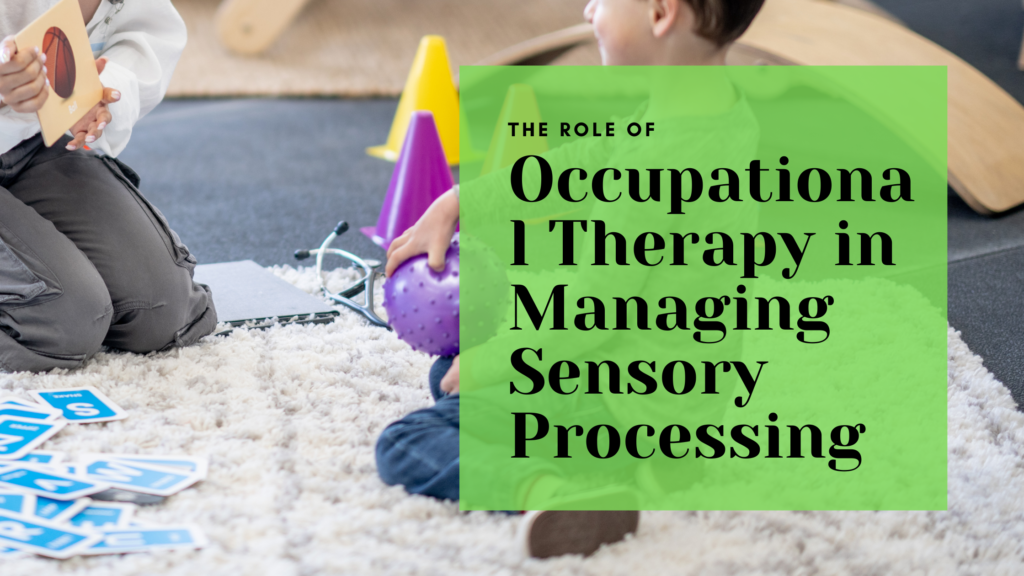I. Introduction
Sensory-seeking behaviors are actions taken by individuals, particularly autistic children, to fulfill their craving for intense sensory experiences. These behaviors may include jumping, spinning, or making loud noises. Sensory seeking is significant in autism because it can impact a child’s ability to focus, socialize, and regulate their emotions.
Although these behaviors help meet the child’s sensory needs, they can pose challenges in daily life, such as disrupting routines or raising safety concerns. This article will provide strategies and interventions to support autistic children with sensory-seeking behaviors, helping parents create safe and effective outlets for their child’s sensory needs.
II. Understanding Sensory Seeking in Autism
Sensory seeking is the tendency to crave intense sensory input, such as movement, sound, or touch. Children who engage in sensory-seeking behaviors often seek out experiences that give them strong sensations, like bouncing, spinning, or rubbing objects. Sensory seeking is different from sensory avoidance, where children react negatively to sensory stimuli and try to avoid them.
Autistic children may engage in sensory-seeking behaviors because their brains do not process sensory information the same way as neurotypical individuals. For some, sensory seeking is a way to regulate their sensory input, as these behaviors provide calming or organizing effects on their nervous system. In some cases, sensory seeking can also be a way for children to get the sensory input they may be missing, such as a child seeking deep pressure by crashing into furniture.
III. Common Sensory Seeking Behaviors in Autistic Children
Movement Seeking
Many autistic children show a strong desire for intense movement, such as running, jumping, spinning, or swinging. They may constantly move or engage in activities that provide vestibular input (balance and movement). For example, a child may enjoy swinging for long periods or spinning in circles.
Tactile Seeking
Children with tactile sensory-seeking behaviors may crave touching objects or people. This could involve rubbing objects against their skin, pressing their hands against rough surfaces, or constantly seeking out new textures to feel. They may also engage in behaviors like squeezing or pressing against objects.
Auditory Seeking
Auditory sensory seekers may seek out loud or rhythmic sounds by humming, banging objects, or making loud vocalizations. They may enjoy making repetitive noises, such as clapping or tapping, to satisfy their need for sound input.
Proprioceptive and Vestibular Seeking
Proprioception refers to body awareness, and vestibular input relates to movement and balance. Children who seek these inputs might engage in activities that provide deep pressure or intense body movement. They may enjoy crashing into objects, swinging, or being tightly hugged.
IV. Challenges Posed by Sensory Seeking Behaviors
Disruption in Daily Routines
Sensory-seeking behaviors can interfere with daily routines, such as transitioning between tasks or preparing for bedtime. A child who is constantly seeking movement might struggle to sit still during meals or focus on a task at school.
Impact on Social Interactions
Sensory-seeking behaviors can also affect a child’s social life. Other children may not understand why a child is constantly moving or making loud noises, which can lead to social difficulties. Peers may misinterpret these behaviors as disruptive, making it harder for the child to form friendships.
Safety Concerns
Some sensory-seeking behaviors, such as crashing into objects or seeking out dangerous situations, can pose safety risks. For example, a child might climb on furniture or run into the street to satisfy their need for intense movement, leading to potential injuries.
V. Strategies for Supporting Sensory Seeking Behaviors
Provide Safe Outlets for Sensory Input
To support a sensory-seeking child, it’s important to create safe and structured outlets for their sensory needs. This could include setting up sensory-friendly play spaces with trampolines, swings, or soft crash pads, where the child can safely engage in movement-seeking behaviors.
Incorporate a Sensory Diet
A sensory diet is a personalized plan of sensory activities designed to meet the child’s needs. Occupational therapists can help develop this diet by including activities that regulate sensory input throughout the day. For instance, a child who seeks movement might benefit from activities like jumping on a trampoline or engaging in structured physical play.
Offer Proprioceptive Input
Proprioceptive activities, such as using weighted blankets, offering deep hugs, or engaging in heavy work activities like pushing or pulling objects, provide the deep pressure input many sensory seekers crave. These activities can help the child feel calm and more grounded.
Use Sensory Tools
Sensory tools like fidget toys, weighted vests, or chewable items can help children satisfy their sensory cravings throughout the day. These tools provide sensory input in a way that doesn’t disrupt daily routines, allowing children to focus and self-regulate more effectively.
VI. Sensory Activities for Different Environments
At Home
Incorporating sensory-friendly activities at home is a great way to support sensory-seeking behaviors. Activities such as jumping on a trampoline, playing with sensory bins filled with sand or rice, or using textured materials during arts and crafts can provide the sensory input the child needs.
At School
In school, teachers can accommodate sensory-seeking behaviors by providing sensory breaks or offering fidget tools during class. Flexible seating, such as allowing the child to sit on a sensory cushion or use a standing desk, can help them focus while also meeting their sensory needs.
In Public
Managing sensory-seeking behaviors in public can be challenging. Bringing portable sensory tools like fidget toys or chewable items can help the child stay calm. It’s also helpful to identify quiet areas where the child can take sensory breaks if needed, or to use noise-cancelling headphones in noisy environments.
VII. Working with Occupational Therapists to Manage Sensory Seeking
Developing a Sensory Diet
Occupational therapists (OTs) play a key role in creating a sensory diet for a child with sensory-seeking behaviors. They assess the child’s specific needs and create a plan of activities that regulate sensory input throughout the day. This sensory diet may include activities like jumping, squeezing, or swinging to help the child maintain sensory balance.
Using Sensory Integration Therapy
Sensory integration therapy (SIT) is an approach used by OTs to help improve how the brain processes sensory information. Through controlled activities that engage the child’s senses, SIT helps them respond to sensory input in a more balanced way, reducing extreme sensory-seeking behaviors.
Collaboration with Teachers and Caregivers
Collaboration between therapists, teachers, and caregivers is essential to ensure consistency across different settings. When everyone is on the same page, the child is more likely to feel supported and succeed in managing their sensory needs both at home and in school.
VIII. Helping Your Child with Emotional Regulation
Teach Calming Techniques
It’s important to teach children calming strategies to help them self-regulate when sensory seeking becomes overwhelming. Techniques like deep breathing, mindfulness, or using a sensory tool can help calm the child when they are overstimulated.
Create Predictable Routines
Structure and routine can reduce anxiety for sensory-seeking children. By creating a predictable schedule that includes sensory activities, children can anticipate when they will get the input they need, helping them feel more in control of their environment.
Positive Reinforcement
Positive reinforcement is a helpful strategy for encouraging appropriate sensory-seeking behaviors. Rewarding the child when they engage in sensory activities safely helps them understand acceptable outlets for their sensory needs.
IX. Balancing Sensory Seeking with Other Needs
Avoid Overstimulation
While sensory input is important, it’s also essential to avoid overstimulation, which can lead to meltdowns or fatigue. Balance sensory activities with calming activities like reading or quiet time to prevent the child from becoming overwhelmed.
Monitor Sensory-Seeking Behavior
Parents should track sensory-seeking behaviors to understand when and where they occur. By monitoring these behaviors, parents can identify patterns and adjust the child’s sensory environment to meet their needs more effectively.
Adjust Strategies as Needed
As children grow, their sensory needs may change. It’s important to regularly adjust the sensory diet, tools, and activities to ensure they continue meeting the child’s needs. Working with an occupational therapist can help parents stay on track with the right strategies.
X. Conclusion
Supporting a child with sensory-seeking behaviors requires a clear understanding of their sensory needs and providing them with safe outlets for those needs. By incorporating sensory-friendly activities, using sensory tools, and developing a sensory diet, parents can help their child feel more comfortable and balanced. Collaborating with occupational therapists, teachers, and caregivers ensures a consistent approach, making it easier for the child to thrive in all settings. With patience, flexibility, and positive reinforcement, children can learn to regulate their sensory input and improve their overall well-being.
References:
- Schaaf, R. C., & Benevides, T. W. (2014). The impact of sensory processing difficulties on daily life in children with autism spectrum disorder. Autism Research and Treatment, 2014, 1-11. https://doi.org/10.1155/2014/716870
- Dunn, W. (2001). The sensory profile: assessing the effect of sensory experiences on daily life in children. Occupational Therapy Journal of Research, 21(1), 4-16. https://doi.org/10.1177/153944920102100102
- Miller, L. J., Anzalone, M. E., Lane, S. J., Cermak, S. A., & Osten, E. T. (2007). Concept evolution in sensory integration: a proposed nosology for diagnosis. American Journal of Occupational Therapy, 61(2), 135-140. https://doi.org/10.5014/ajot.61.2.135
- Baranek, G. T. (2002). Efficacy of sensory and motor interventions for children with autism. Journal of Autism and Developmental Disorders, 32(5), 397-422. https://doi.org/10.1023/A:1020541906063
Here’s a table with 10 key points based on the article:
| # | Key Point | Description |
|---|---|---|
| 1 | Understand Sensory Seeking Behaviors | Sensory seeking is when a child craves intense sensory input (e.g., movement, touch, or sound) to regulate their system. |
| 2 | Identify Common Sensory Seeking Behaviors | Recognize behaviors like spinning, jumping, making loud noises, or excessive touching as signs of sensory seeking. |
| 3 | Provide Safe Outlets for Sensory Input | Offer safe, structured activities that allow your child to fulfill their sensory needs, such as trampolines or swings. |
| 4 | Create a Sensory Diet | Work with an occupational therapist to develop a sensory diet tailored to your child’s specific sensory needs, with activities throughout the day. |
| 5 | Use Sensory Tools | Provide tools like fidget toys, chewable items, and weighted vests to help your child regulate their sensory input. |
| 6 | Incorporate Sensory Activities into Daily Routines | Include sensory-friendly activities at home, school, and in public, such as using sensory bins, flexible seating, or noise-cancelling headphones. |
| 7 | Balance Sensory Input | Ensure that sensory seeking doesn’t lead to overstimulation by balancing stimulating activities with calming breaks. |
| 8 | Collaborate with Therapists and Teachers | Work closely with occupational therapists and educators to ensure consistent support for sensory-seeking behaviors across different environments. |
| 9 | Teach Self-Regulation Techniques | Help your child learn calming strategies like deep breathing or mindfulness to manage overwhelming sensory input. |
| 10 | Monitor and Adjust Sensory Interventions | Sensory needs may change over time, so regularly assess your child’s sensory-seeking behaviors and adjust strategies as needed. |
This table provides key points to consider when supporting an autistic child with sensory-seeking behaviors, offering practical strategies for managing sensory needs.


